“We want to go to Europe.” This quote comes from Werder Bremen’s sporting director Frank Baumann at a press conference before the start of the season. Despite the loss of key player Max Kruse, Werder Bremen started with ambitious goals into the season and wanted to qualify for the Europa League next year with attractive offensive football. However, after the worst first half of a season in their history and a bad start into the second half, relegation is closer than ever. It’s everything but an exaggeration to say that Bremen’s season has gone from unlucky to very, very ugly. This didn’t happen in the blink of an eye but was the result of many circumstances and bad developments. Even Florian Kohfeldt, Germany’s highly praised coach of the year 2019, seems to be helpless.
In this tactical analysis we will point out what’s going wrong at Werder Bremen and how things cold turn out so dramatically. This scout report will further look at Florian Kohfeldt’s tactics and his standing within the club.
What happened?
After an exciting season with many highlights, Werder Bremen just missed out on 7th place in the 2018/2019 season, which would have entitled them to the Europa League. The squad of Florian Kohfeldt performed an entertaining offensive football, not comparable to their rudderless style a year before. Kohfeldt showed his tactical versatility by using a 4-diamond-2, 3-5-2 or his preferred 4-3-3. Many players like Maximilian Eggestein, Milot Rashica or even Max Kruse have seen massive improvements under him.
However, despite their good season, Bremen had a very tough summer. With Max Kruse they lost not only their captain but the decisive player of the team – the linchpin of their attack. The whole system of Kohfeldt was designed around him as the focal point. What made it even worse: They didn’t get anything in return as he left on a free transfer. And after nine years without income from European competitions, Werder just didn’t have a lot of money to spend.
While Michael Gregoritsch was identified as their favoured successor of Kruse, they eventually couldn’t afford him. Consequently, they decided to not buy another player, but stick with those at hand and hope that Yuya Osako can make the next step in a new role. And this is – in many ways – where the problems started.
Osako was just one of many players that suffered from injuries throughout the first half of the season. Already at the beginning of the season, Kohfeldt had to constantly reorganise his team. This also led to the last-minute transfers of Leonardo Bittencourt and Michael Lang.
Among so many injury problems, Kohfeldt’s squad has never looked less cohesive. The coach tried to focus on what was happening on the pitch. Nevertheless, it cannot be denied that injury problems played a significant role throughout the season. Especially in defense, he was struggling to field a consistent side because his players were dropping like flies.
In addition, many players were running after their form for a long time as there were no alternatives. The best example for that is Eggestein, who was one of the rising stars last year. Having played the U21-European-Championship in the summer, he hasn’t had much time to recover and could rarely convince.
What Expected Goals say
Even though Werder Bremen lost their first two matches of the season against Düsseldorf and Hoffenheim, their start, in general, was actually not that bad. They quickly recovered from these losses and established themselves in the lower midfield of the league table. They were far from touching upon the Europa League ranks, but few could have guessed that the situation would deteriorate so dramatically.
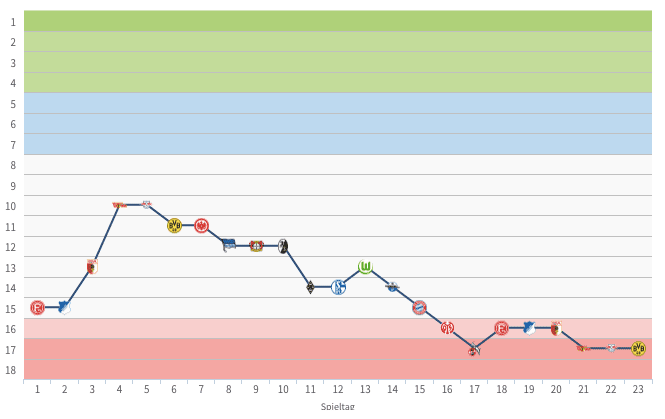
When looking at the development of their league position, it’s apparent that it was after the match against Wolfsburg where things started to rattle. Bremen just got a highly important win at Wolfsburg after eight matches without a win. Up next, they had to face Paderborn and wanted to build upon this result, finally starting to climb up the table. As we now know, this didn’t work out but ended up in a last-minute win for Paderborn – their first of the season.
This development can be illustrated very well by taking a look at their Expected Goals and Expected Goals Against trendlines as shown below. While everything looked alright at first, things became apparently worse after a while.
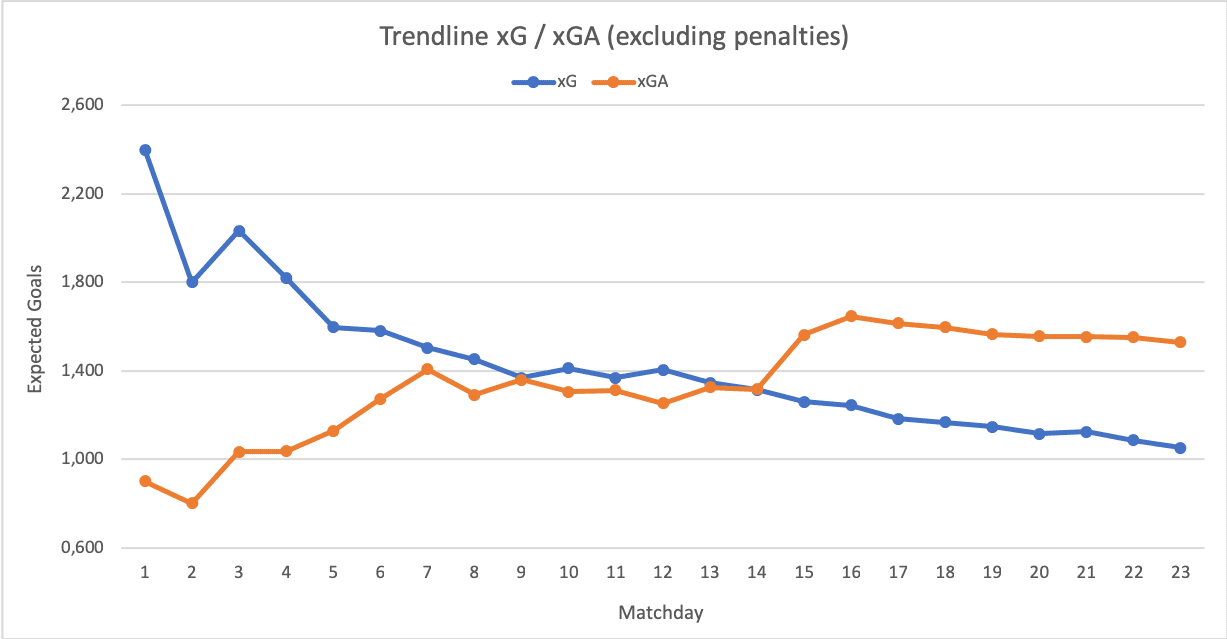
With that in mind, it might make sense to look at Bremen’s season from two perspectives. During the first 13 matches of the season, Bremen have a slightly positive xG-Difference (0.26). During the ten matches since then, their xG-Difference is -10.94. Having been unlucky at the beginning of the season, they have become really, really bad. In their last ten matches, they were outscored by every opponent according to xG. The opponents during this period included almost all direct competitors such as Mainz 05, Paderborn or Düsseldorf.
Defensively, one can also spot a difference comparing the first 13 and the next ten matches. However, the difference is not that significant as offensively and strongly affected by the humiliating losses against Bayern and Mainz. Using the xG-metric, it becomes clear that Bremen have actually defended even better than the raw numbers suggest. In fact, they have the 11th lowest xGA-figure in the league with 35.24. The numbers show: Bremen have conceded almost 18 goals more than expected, which points down to a mix of bad luck and very efficient opponents.
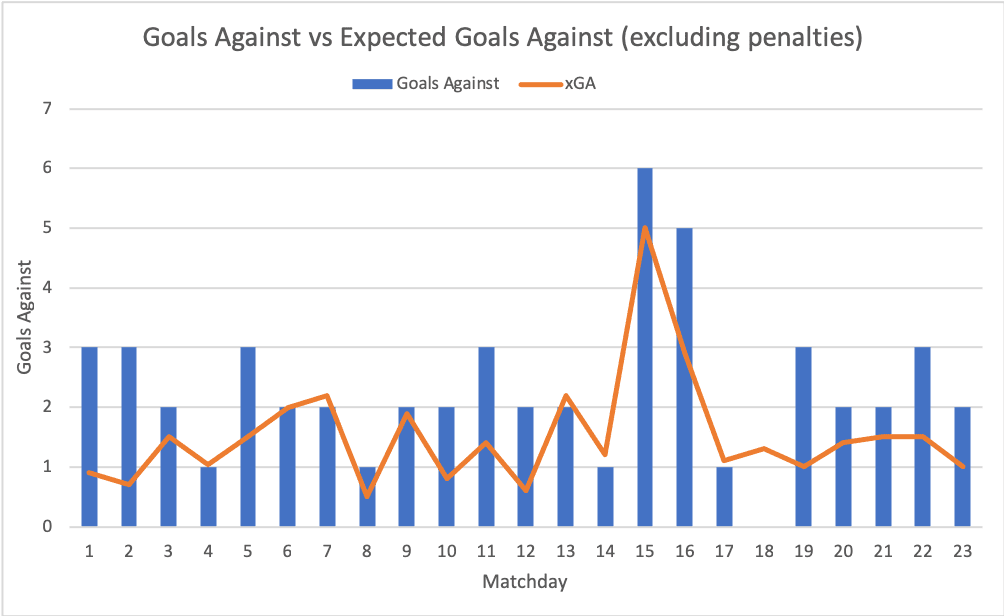
Offensively, the decline is even more significant: While they scored 1.35 xG/game before the match against Paderborn, they only averaged 0.67 xG/game since then. In addition, they only created two chances, that can be considered as high-quality ones (>0.3). A result from the shift in focus, trying to stabilize the defense? We will take a closer look on that later.
Defensive struggles
Werder Bremen have traditionally never been very good defensively. It might sound counterintuitive, but based on the numbers we just discussed, Bremen have actually never looked that bad defensively this season compared to their numbers last year. In 2018/2019, they averaged 1.58 xGA/game, which means that they were even better for most parts this season. Don’t get me wrong: Even 1.58 xGA/game last year was everything but a good figure, yet, maybe things have been slightly overrated.
To point that out further, we have to look back at the first half of the season. Until the win against Wolfsburg, they conceded 1.32 xGA/game. They were just unlucky and suffered from individual mistakes, having actually conceded 2.15 goals/game. When the heavy defeats against Bayern and Mainz came on top of that, Kohfeldt and his team felt forced to change something and focused solely on defensive stability.
The match, where this approach became really visible for the first time was against Cologne. What happened was a very deep-lying Bremen team, which only focused on defending. This resulted in a partly bizarre first-half, in which Cologne – at that time also strongly in danger of relegation – had temporarily 89% ball possession.
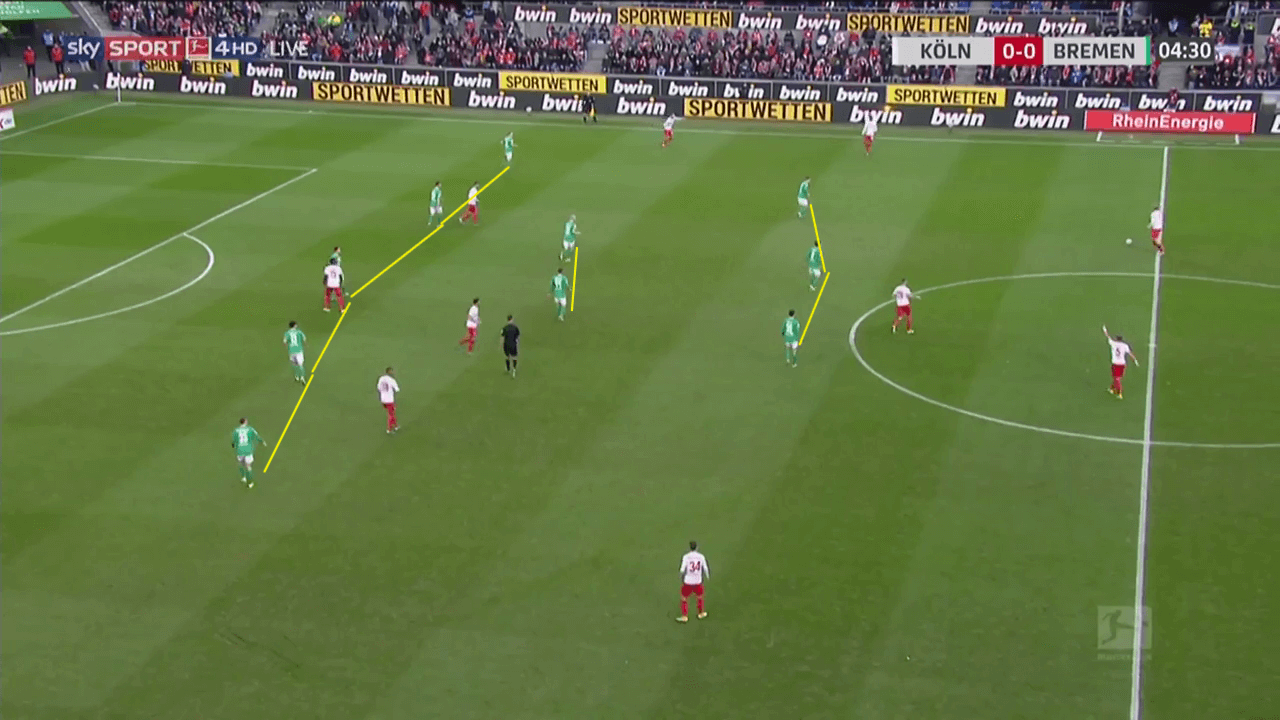
In the winter, sporting director Frank Baumann made an effort to address the defensive issues with the acquisition of former Hoffenheim captain Kevin Vogt. Considering Vogt’s role in Hoffenheim as the central part of a back three, Florian Kohfeldt seemed to have settled on a 5-3-2/5-2-3 as the new system to strengthen the defense.
In fact, their defensive structure in 2020 looks very similar to the one we just saw. Especially against individually stronger opponents, Kohfeldt’s team tries to minimize the spaces in the midfield and block the passing lanes into central areas.
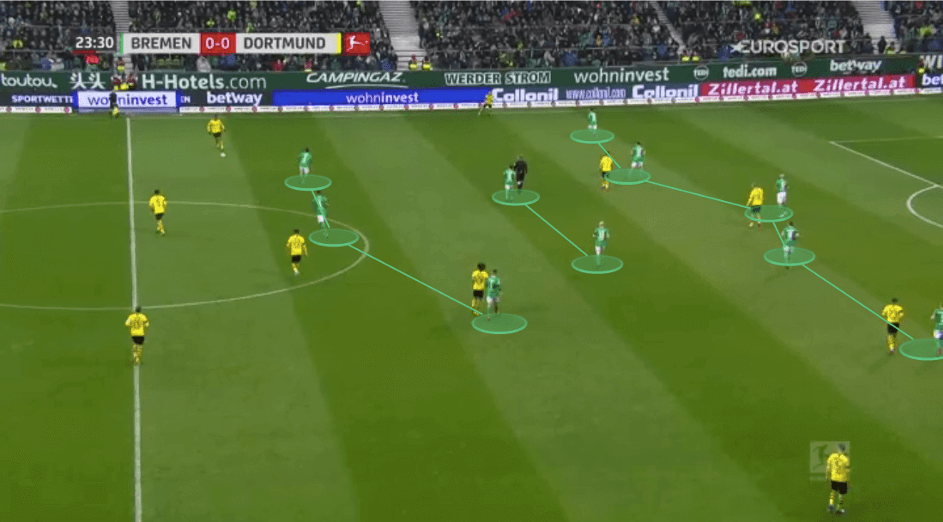
In some ways, this “Safety-First” approach has worked so far. For the most part, Bremen defends solidly, with good distances between defense and midfield. It’s quite remarkable that in 6/7 matches in the second half of the season, Bremen didn’t concede a goal within the first 45 minutes. However, as soon as an opponent exerts considerable pressure, you can see the uncertainty within the team that leads to them dropping too far and acting too passively. The example below against Augsburg illustrates that. They ultimately conceded two goals and lost the game despite their lead at half-time.
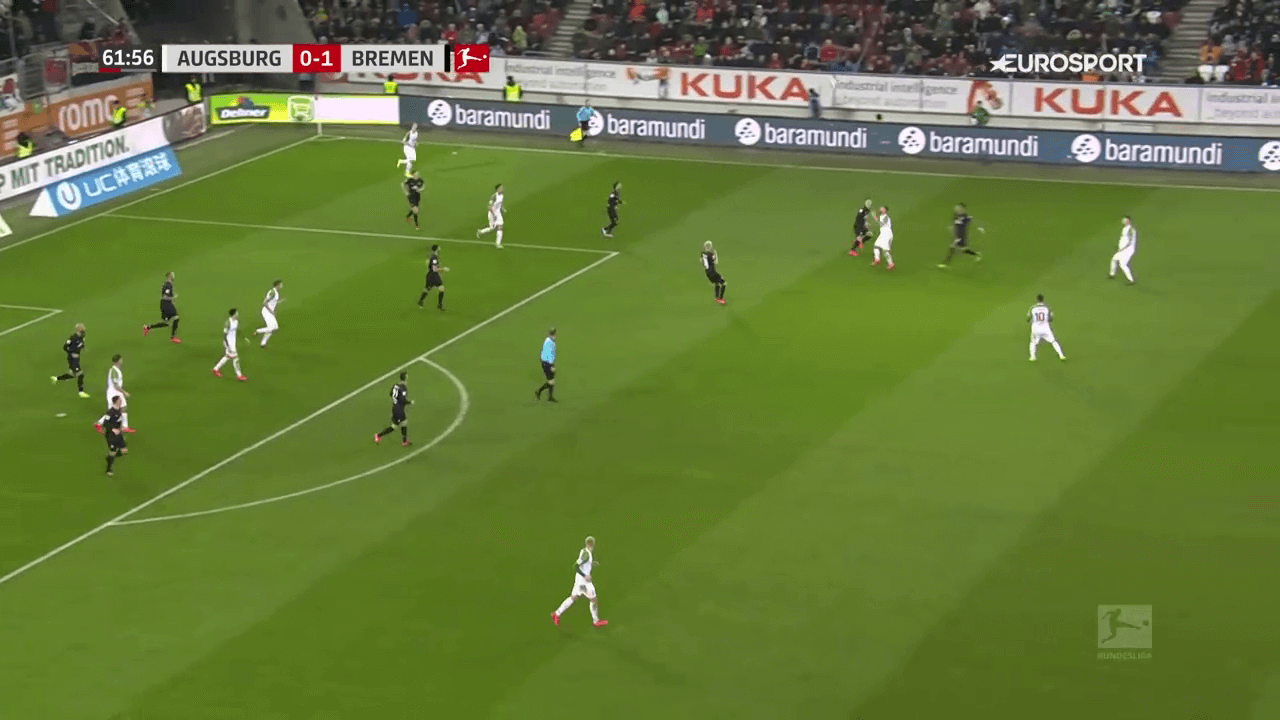
As we’ve just seen, Werder have been consistent in conceding significantly more goals than expected this season. It’s possible that some of this is the fault of Jiri Pavlenka, who has never looked impressive in the shot-stopping numbers. Instead, his numbers this season make for ugly reading. Pavlenka ranks second to bottom among Bundesliga starting goalkeepers for overall save percentage (56.7%). This means a drastic decrease compared to last year (71.2%). It gets even worse when looking at his post-shot expected goals minus goals allowed. According to this figure, he is the worst goalkeeper in the league, having allowed 11.8 goals (0.51 per game) more than the average goalkeeper would have been expected to. To put it differently: in every second match, he concedes a goal through a shot he should have saved.
Talking about Bremen and their defensive issues, one inevitably comes across their high susceptibility at set-pieces, a major concern throughout the season. Bremen conceded 17 goals after set-pieces – most in the Bundesliga. Whether it was man marking, zonal marking or a mixture of both: they tried it all, but nothing helped. However, set pieces have essentially nothing to do with the general approach of a team. This leads us again to the question whether it was even necessary to focus so much on defense and neglect the offensive part. Furthermore, this is a problem that can only be attributed to Florian Kohfeldt to a limited extent. It is usually the assistant coach who takes care of set pieces and Werder hired Ilia Gruev specifically for this before the season.
Offensive struggles
As indicated, it’s the attacking side, though, where it looks really dramatic. One goal (Rashica against Bayern) in the last ten games clarifies the issue. In 2020, Bremen haven’t scored a goal at all but profited from two own goals against Düsseldorf and Augsburg. In other words: they didn’t score a goal for 784 minutes. If we think of the relatively good xG-numbers at the beginning of the season this is surprising in many ways and leaves one wondering.
Bremen’s approach under Kohfeldt is usually very much focused on central areas of the pitch. Whenever Kohfeldt opts in for three strikers, it’s mostly Yuya Osako who plays as a false nine and drops deep to support the build-up. The other strikers position themselves relatively narrowly so that a 4-3-3 can quickly become a 4-diamond-2. The picture below stems from the first match of the season against Düsseldorf.
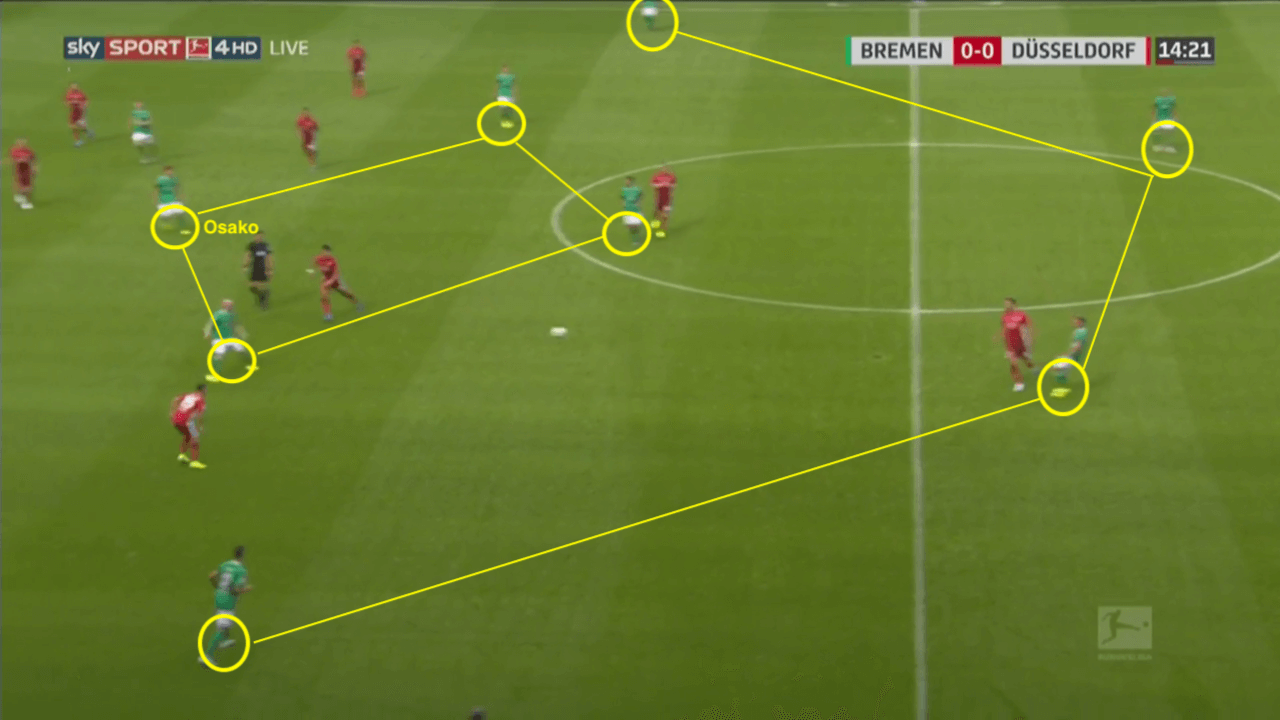
Despite the switch to three at the back, their build-up-approach has only slightly changed. Now, they frequently line up in 5-2-3 in possession with highly-positioned full-backs. However, this can vary at times, when one of the strikers drops deep to form a triangle in midfield.
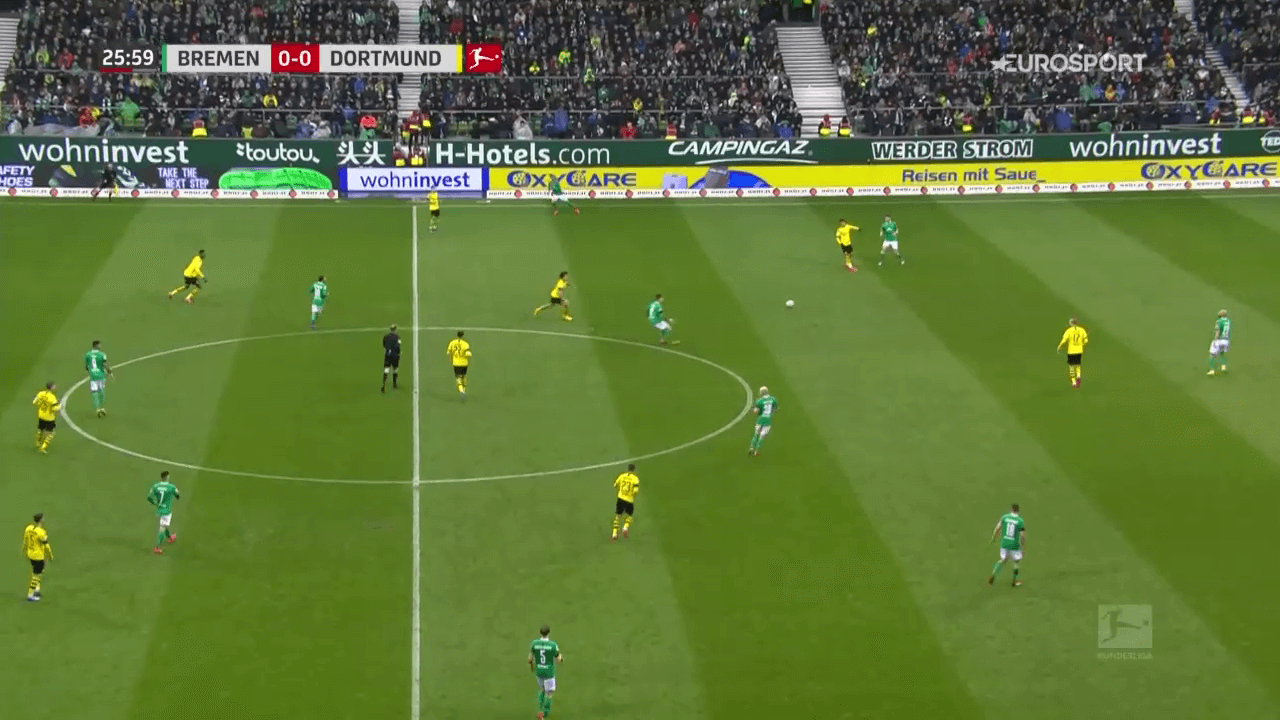
Their general approach in possession still remains very similar – even in those difficult times. The main problem of Kohfeldt’s squad, however, are the offensive transition moments. Their style of play is no longer designed to act out of possession but to use quick counter-attacks to exploit the opponent’s defense. That being said, Bremen are currently far too rarely able to implement these tactics and find the right balance between offense and defense.
These problems could be seen in the game against FC Augsburg when they took the lead but were way too passive in the second half, lacking any offensive action. We’ve already seen the example below, but it perfectly illustrates how deep Bremen dropped at times, having all players within 30 meters in front of their own goal. Thus, it was very difficult to do anything offensively.

The next example also puts emphasis on Bremen’s problems in transition moments: the distances between the deep-lying midfield and the relatively high-positioned strikers. As the other players don’t support their attackers, they are clearly outnumbered, eventually leading to another harmless long-range shot from Milot Rashica.
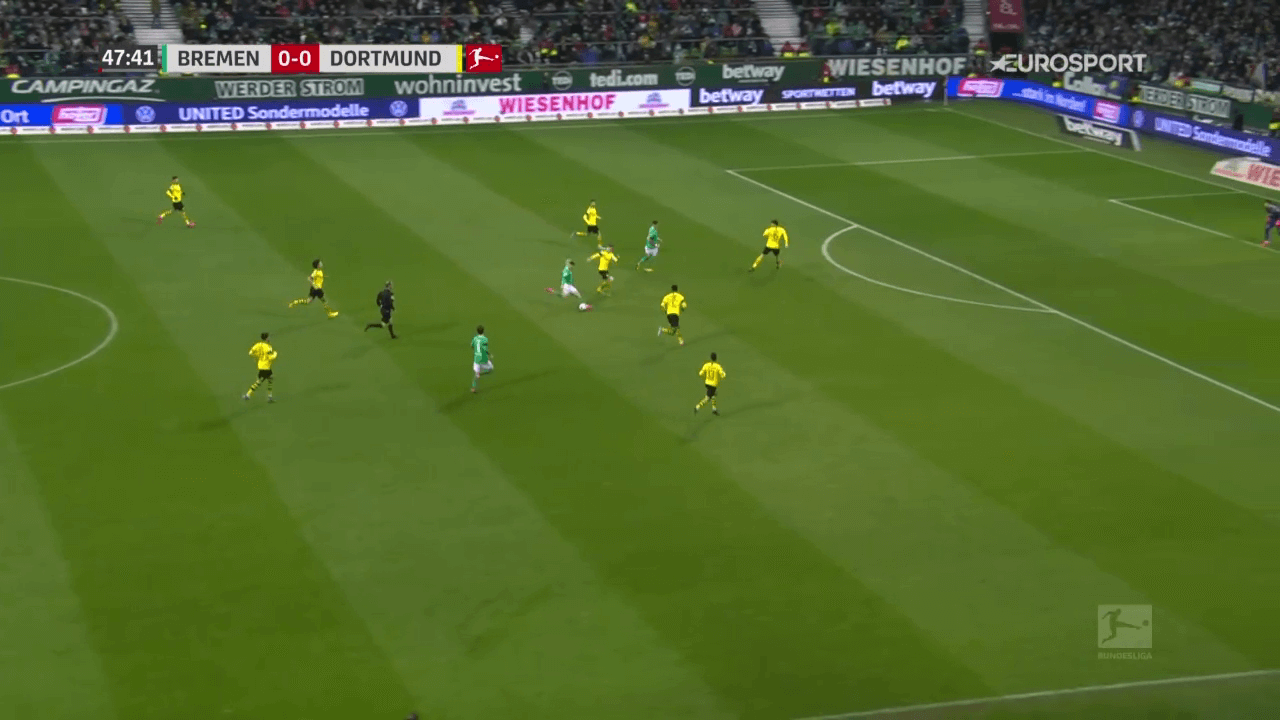
Rashica is a good example. It’s widely known that he’s the most talented and apparently most dangerous player, not only when it comes to counter attacks. He’s speedy, good at dribbles, and currently their most prolific goal scorer. This brings us to the problem. The Kosovan is a very good player, but he’s certainly not the only player that you want to rely on when it comes to scoring goals. He only amasses 0.06 NPxG/Shot, which can be explained by his strange shot locations.
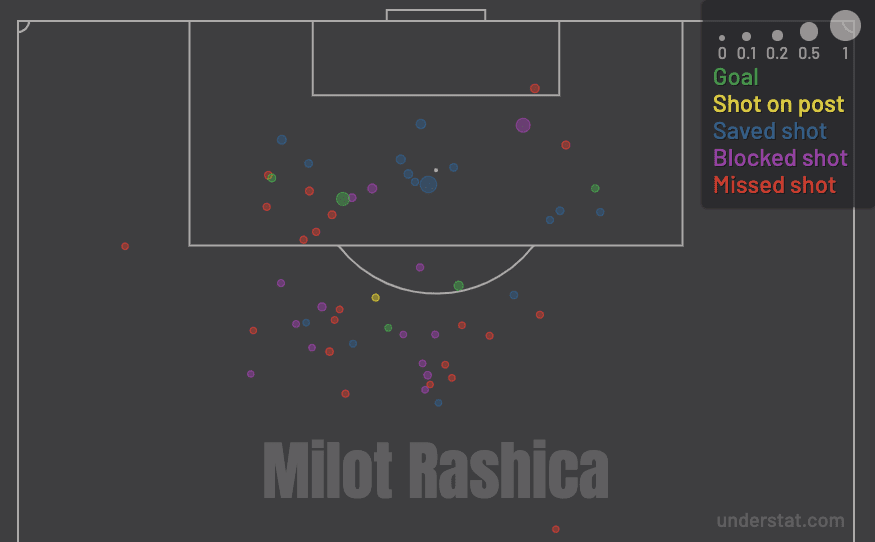
Nonetheless, it would be too easy to blame his shot selection solely on him. Especially in previous games, it’s also a lack of support of his teammates when Bremen tries to attack as shown above. Still, it might not be the best solution to always shoot from outside the box, but given the circumstances, it can be partially explained and is a general problem of Bremen. The lack of creating high-quality chances at all paired with the incapacity to convert the chances at hand is further illustrated in the graph beneath. Especially Bremen’s finishing is horrendous, only converting 6.82% of their shots.
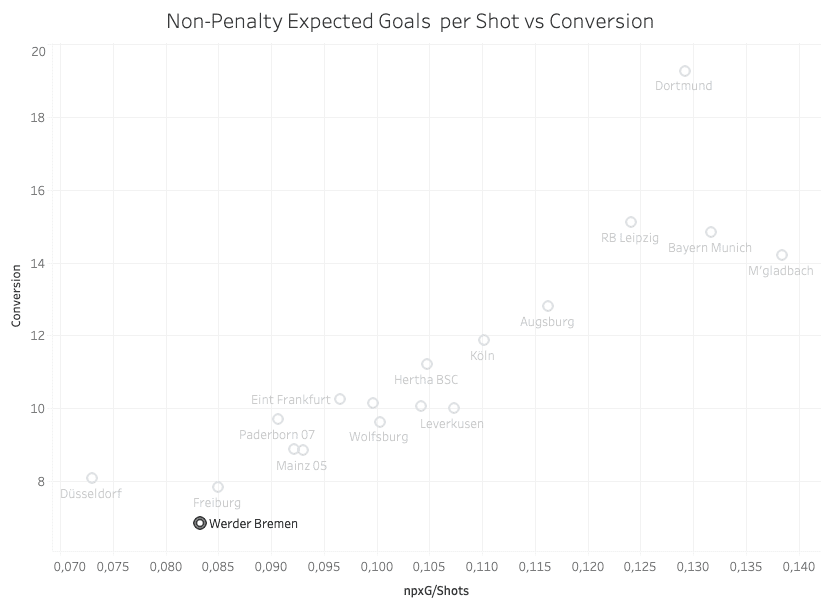
Despite all justified criticism, however, Bremen has also shown some quite decent approaches. Especially against Leipzig, there were some good moments in transition when Osako was able to protect the ball upfront and then pass to one of the wingers Rashica or Bittencourt.
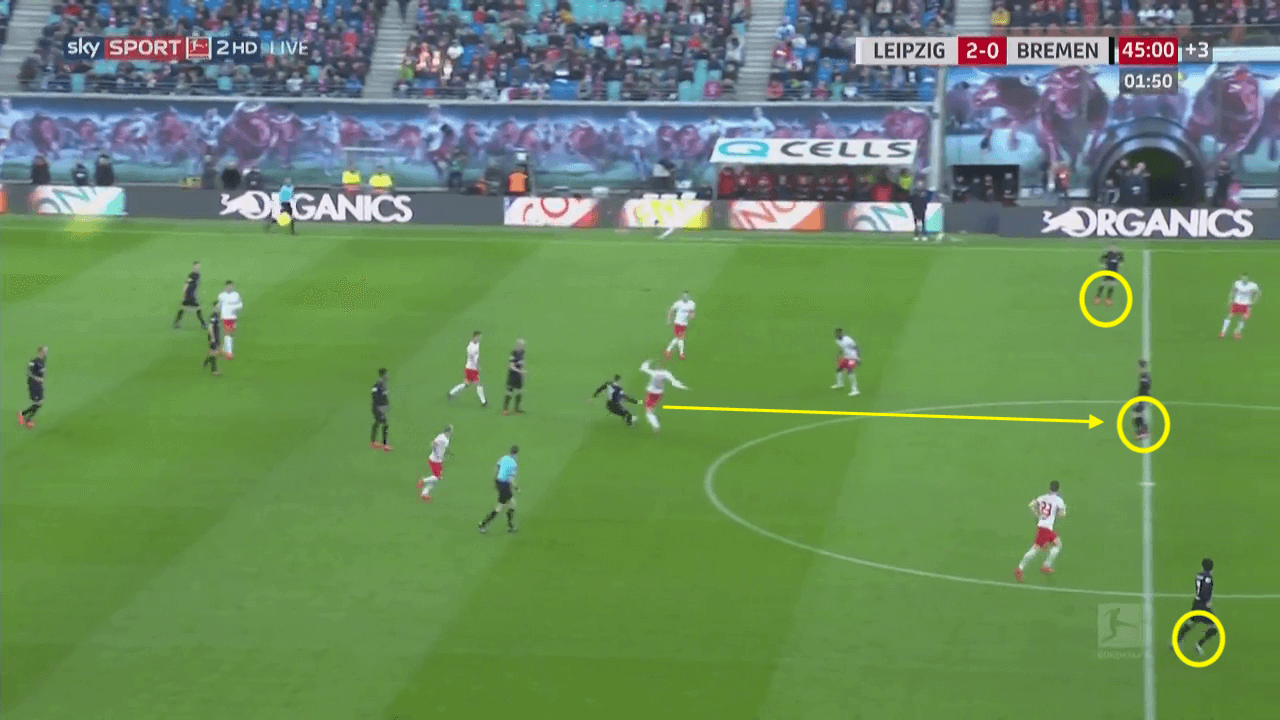
Also, the support of the midfielders was appropriate in this situation. Thus, Bremen were able to create numerical equality in the penalty area and create a dangerous situation.
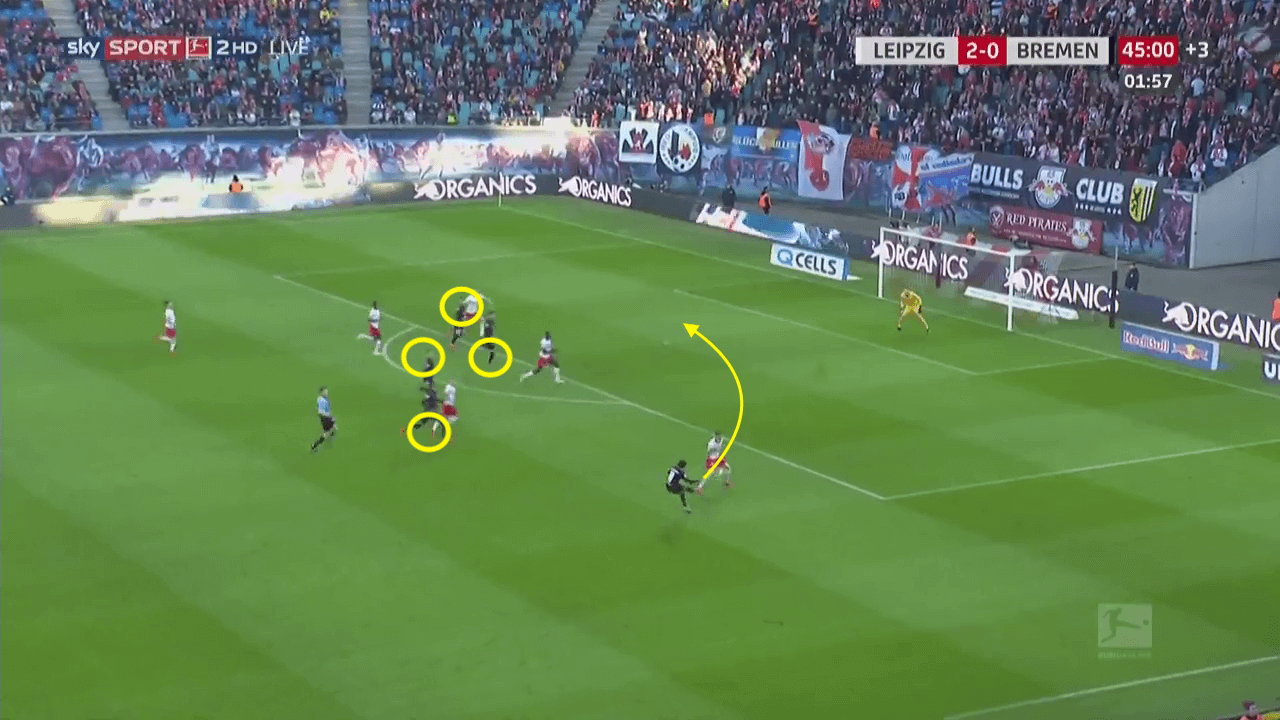
What about Florian Kohfeldt?
To understand things that are currently going on in Bremen, one might need a bit of background information about the club. If you’re in your mid 20’s like me, you will probably remember some of the legendary European nights with players like Ailton, Johan Micoud or Diego. However, the last European Cup match of Bremen goes back to the 7th of December 2010 when they beat Inter Milan 3-0 in their own stadium. Since then, Bremen has been more concerned with the fight against relegation in most seasons – until Florian Kohfeldt was promoted from the second team to head coach in autumn 2017.
Now, for the first time since his promotion, Kohfeldt’s position is being questioned and potential successors are being discussed. At least in the media. Within the club, notwithstanding the bad results, he still enjoys the confidence of sporting director Baumann and the board around chairman Marco Bode. Considering their league position and especially the negative trend, this might seem completely ridiculous to some people. Any other coach would almost certainly have been fired by now.
But the story with Kohfeldt is different – he is the identification figure of Bremen’s upturn. That’s not only because of his tactical qualities as a coach but also because of his charisma and his positive appearance. After years in the no-man’s-land of the table, he has given the club hope and confidence in a better future like for many years in the 2000s under Thomas Schaaf.
Nevertheless, at some point, he too will be judged by the performance on the pitch and the results. Florian Kohfeldt’s Werder always stood for bold and attractive offensive football: high pressing, sophisticated build-up through the midfield, and quick combinations. Currently, there is not much left of this style and it seems as if Kohfeldt is still searching for the right approach to turn things around. Nevertheless, the coach still enjoys a high level of trust and has shown, e.g. in the cup, that he still has ideas and solutions.
Conclusion
For a long time, Werder Bremen seemed to be a team that can be branded “too good to go down”. However, based upon their previous results – and, in particular, their poor goalscoring numbers, Bremen are in real danger to get relegated for the first time since 1980. They’re simply not good enough right now. This, to be fair and offer glimmers of hope is also true to Fortuna Düsseldorf, their current main competitor.
That being said, now it’s up to Florian Kohfeldt and his squad to turn things around. For the first time of the season, he finally got his whole squad together, apart from the long-term injured Niclas Füllkrug. This opens up new opportunities. Much will depend on how they manage to regain their offensive strength and thus find the right balance between defensive stability and quick transition moments. Another glimmer of hope: They have already shown how it can work when they beat Borussia Dortmund in the DFB Pokal.
By the time this analysis is published, Bremen will have already played against Hertha BSC Berlin, a club that has to deal with their own problems. The importance of this match cannot be higher and will give us a clearer idea of the direction Werder Bremen will take: Rescue or Relegation?




Comments